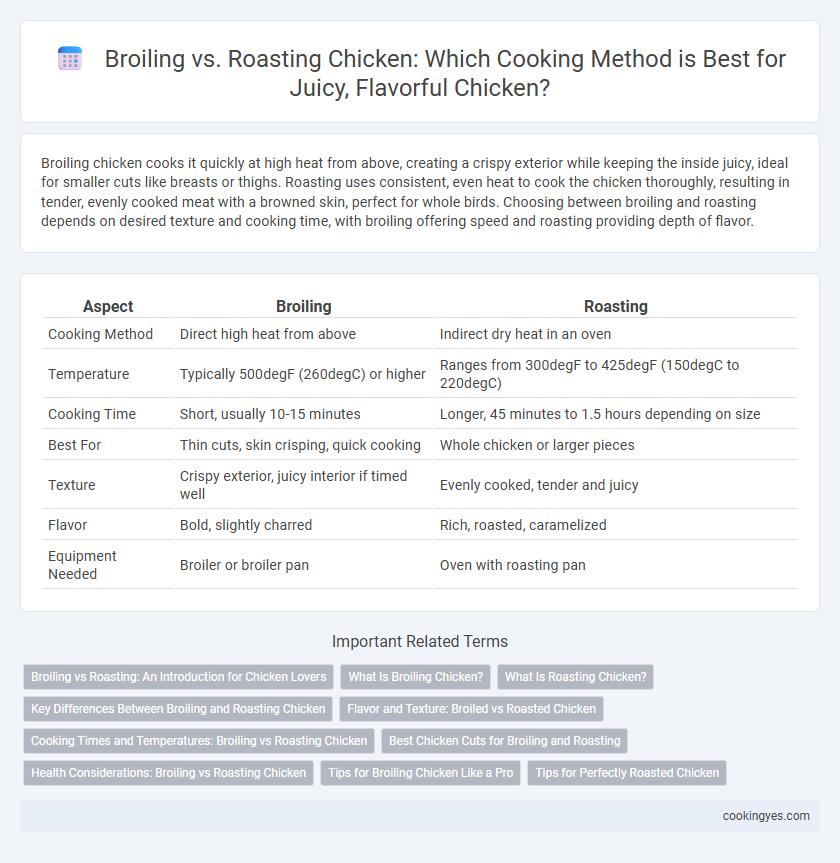Broiling chicken cooks it quickly at high heat from above, creating a crispy exterior while keeping the inside juicy, ideal for smaller cuts like breasts or thighs. Roasting uses consistent, even heat to cook the chicken thoroughly, resulting in tender, evenly cooked meat with a browned skin, perfect for whole birds. Choosing between broiling and roasting depends on desired texture and cooking time, with broiling offering speed and roasting providing depth of flavor.
Table of Comparison
| Aspect | Broiling | Roasting |
|---|---|---|
| Cooking Method | Direct high heat from above | Indirect dry heat in an oven |
| Temperature | Typically 500degF (260degC) or higher | Ranges from 300degF to 425degF (150degC to 220degC) |
| Cooking Time | Short, usually 10-15 minutes | Longer, 45 minutes to 1.5 hours depending on size |
| Best For | Thin cuts, skin crisping, quick cooking | Whole chicken or larger pieces |
| Texture | Crispy exterior, juicy interior if timed well | Evenly cooked, tender and juicy |
| Flavor | Bold, slightly charred | Rich, roasted, caramelized |
| Equipment Needed | Broiler or broiler pan | Oven with roasting pan |
Broiling vs Roasting: An Introduction for Chicken Lovers
Broiling chicken uses direct, high heat from above to cook quickly, resulting in a crispy exterior and juicy interior, ideal for thin cuts like breasts or wings. Roasting involves cooking chicken evenly in an oven at moderate heat, perfect for whole birds or larger pieces, enhancing flavor through slow caramelization and browning. Both methods bring distinct textures and flavors, making them essential techniques for chicken lovers seeking variety in their cooking.
What Is Broiling Chicken?
Broiling chicken involves cooking it under direct high heat from above, typically in an oven's broiler compartment, which quickly sears the surface while locking in juices. This method is ideal for thinner cuts like chicken breasts or wings, providing a crispy exterior without drying out the meat. Broiling reaches temperatures around 500degF to 550degF, offering a fast cooking option compared to roasting.
What Is Roasting Chicken?
Roasting chicken involves cooking the bird in an oven at a consistent temperature, typically between 325degF and 450degF, allowing even heat to circulate and cook the meat thoroughly. This method produces a crispy, golden-brown skin and tender, juicy meat by rendering fat and locking in moisture. Roasting is ideal for whole chickens or large cuts, preserving flavor and ensuring a uniformly cooked result.
Key Differences Between Broiling and Roasting Chicken
Broiling chicken exposes it to direct high heat from above, cooking it quickly with a crispy exterior, ideal for thinner cuts or quick meals. Roasting uses indirect, evenly distributed heat in an enclosed oven, allowing for thorough cooking and moisture retention, suited for whole chickens or larger pieces. Key differences include cooking time, heat source, and texture outcomes, with broiling emphasizing speed and crispiness, while roasting emphasizes even cooking and juiciness.
Flavor and Texture: Broiled vs Roasted Chicken
Broiling chicken results in a crispy, caramelized exterior with a juicy, tender interior due to high direct heat exposure. Roasting chicken evenly cooks the meat with a browned skin and a moist, tender texture through slower, indirect heat circulation. Flavor intensity in broiled chicken is more pronounced with a slight char, while roasted chicken offers a deeper, evenly developed savory profile.
Cooking Times and Temperatures: Broiling vs Roasting Chicken
Broiling chicken typically requires high heat at around 500degF (260degC) for a shorter time, usually 10-15 minutes, to quickly cook and brown the surface while keeping the interior juicy. Roasting chicken is done at lower temperatures, generally between 350degF and 400degF (175degC to 205degC), with cooking times ranging from 45 minutes to over an hour, depending on the size, allowing even heat penetration and tender, fully cooked meat. Proper temperature control and cooking duration are essential in both methods to ensure food safety and optimal texture.
Best Chicken Cuts for Broiling and Roasting
Breast and thigh cuts are best suited for broiling due to their relatively uniform thickness, allowing even cooking and crispy, caramelized surfaces. Whole chickens and bone-in leg quarters perform better when roasted, as the dry heat evenly penetrates the meat, retaining moisture while developing rich, roasted flavors. Selecting the appropriate cut optimizes texture and taste based on the cooking method.
Health Considerations: Broiling vs Roasting Chicken
Broiling chicken cooks it quickly at high heat, which helps retain more vitamins like B6 and niacin while reducing fat by allowing it to drip away. Roasting involves slower cooking at moderate temperatures, promoting even cooking and caramelization but may increase exposure to advanced glycation end products (AGEs), linked to inflammation. Choosing broiling over roasting can minimize fat intake and preserve more nutrients, aligning better with health-conscious diets.
Tips for Broiling Chicken Like a Pro
Broiling chicken requires precise control of heat and timing to achieve a juicy interior and crispy exterior; position the oven rack 4 to 6 inches from the broiler element for optimal browning. Marinate the chicken or apply a dry rub with olive oil, garlic, and herbs to enhance flavor and prevent dryness during the high-heat cooking process. Use a wire rack to allow fat to drip away and turn the chicken halfway through cooking to ensure even broiling and avoid burning.
Tips for Perfectly Roasted Chicken
For perfectly roasted chicken, maintain an oven temperature between 375degF and 425degF to achieve a crispy skin while preserving juicy meat. Use a meat thermometer to ensure the internal temperature reaches 165degF, preventing undercooking or dryness. Basting the chicken periodically with its own juices enhances flavor and moisture throughout the roasting process.
Broiling vs Roasting for Chicken Infographic

 cookingyes.com
cookingyes.com